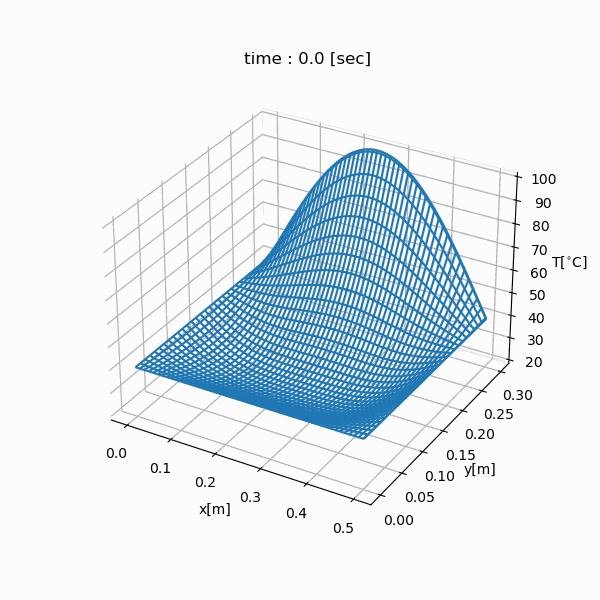Example: Thermal Simulation (SCA Implementation)
Objective
We will simulate the temporal change in temperature of the copper rectangle whose length is 50 cm (= LX), width is 30 cm (= LY) using a finite-difference method.
Physics
Governing Equation
Variable |
Description |
|---|---|
Temperature [K] |
|
Time [s] |
|
x coordinate [m] |
|
y coordinate [m] |
Constant |
Description |
Value of Copper |
|---|---|---|
Thermal conductivity |
398.0 [W/m K] |
|
Density |
8960.0 [kg/m 3] |
|
Specific heat capacity |
385.0 [J/kg K] |
Boundary Conditions
Initial Conditions
Program
import nlcpy as vp
from matplotlib import pyplot as plt
from matplotlib import animation
LX = 50e-2
LY = 30e-2
T0 = 20.0
T1 = 40.0
T2 = 60.0
HC = 398.0 / (8960.0 * 385.0)
WFRAME = None
DT = 'float32'
def initialize(grid):
grid.fill(T0)
grid[:, 0] = T1
grid[:, -1] = T1
grid[0] = T1
grid[-1] = T1 + T2 * \
vp.sin(vp.pi * vp.linspace(0, LX, grid.shape[1]) / LX)
def create_stencil_kernel(grid_work1, grid_work2, coef):
kernels = []
dgrid1, dgrid2 = vp.sca.create_descriptor((grid_work1, grid_work2))
# input: grid_work1, output: grid_work2
desc = ((dgrid1[0, -1] + dgrid1[0, 1]) * coef[0] +
(dgrid1[-1, 0] + dgrid1[1, 0]) * coef[1] +
dgrid1[0, 0] * coef[2])
kernels.append(vp.sca.create_kernel(desc, desc_o=dgrid2[0, 0]))
# input: grid_work2, output: grid_work1
desc = ((dgrid2[0, -1] + dgrid2[0, 1]) * coef[0] +
(dgrid2[-1, 0] + dgrid2[1, 0]) * coef[1] +
dgrid2[0, 0] * coef[2])
kernels.append(vp.sca.create_kernel(desc, desc_o=dgrid1[0, 0]))
return kernels
def heatequation(
nx, # The number of grid points in X-direction.
ny, # The number of grid points in Y-direction.
dt, # The time step interval.
mt, # The maximum number of time steps.
kp, # The number of time steps for drawing interval.
):
mx = nx + 2
my = ny + 2
grid_work1 = vp.sca.create_optimized_array((my, mx), dtype=DT)
grid_work2 = vp.sca.create_optimized_array((my, mx), dtype=DT)
dx = LX / (nx + 1)
dy = LY / (ny + 1)
coef = [
(HC * dt) / (dx * dx),
(HC * dt) / (dy * dy),
1.0 - HC * dt * (2.0 / (dx * dx) + 2.0 / (dy * dy)),
]
x = vp.linspace(0, LX, mx)
y = vp.linspace(0, LY, my)
xx, yy = vp.meshgrid(x, y)
print("initializing grid...", end="", flush=True)
initialize(grid_work1)
grid_work2[...] = grid_work1
print("done", flush=True)
print("creating stencil kernel...", end="", flush=True)
kernels = create_stencil_kernel(grid_work1, grid_work2, coef)
print("done", flush=True)
grid_for_plot = [grid_work1, ]
fig = plt.figure(figsize=(6, 6))
ax = fig.add_subplot(111, projection='3d')
print("computing difference method...", end="", flush=True)
for i in range(int(mt/dt)):
grid = kernels[i % 2].execute()
if i % int(kp/dt) == 0:
grid_for_plot.append(grid.get())
print("done", flush=True)
def animate(i):
global WFRAME
if WFRAME:
ax.collections.remove(WFRAME)
WFRAME = ax.plot_wireframe(
xx, yy, grid_for_plot[i], rstride=10, cstride=10)
ax.set_title('time : {:2.1f} [sec]'.format(i * kp))
def animate_init():
ax.set_xlabel("x[m]")
ax.set_ylabel("y[m]")
ax.set_zlabel("T[$^{\circ}$C]")
ax.zaxis.set_rotate_label(False)
ax.set_zlim(T0, T1 + T2)
print("creating animation...", end="", flush=True)
animation.FuncAnimation(
fig,
animate,
interval=200,
frames=int(mt / kp + 1),
repeat=False,
init_func=animate_init
).save(
"thermal_simulation.gif",
writer='pillow'
)
print("done", flush=True)
for kern in kernels:
vp.sca.destroy_kernel(kern)
if __name__ == "__main__":
heatequation(500, 300, 0.001, 30, 1.)
Simulation Result
